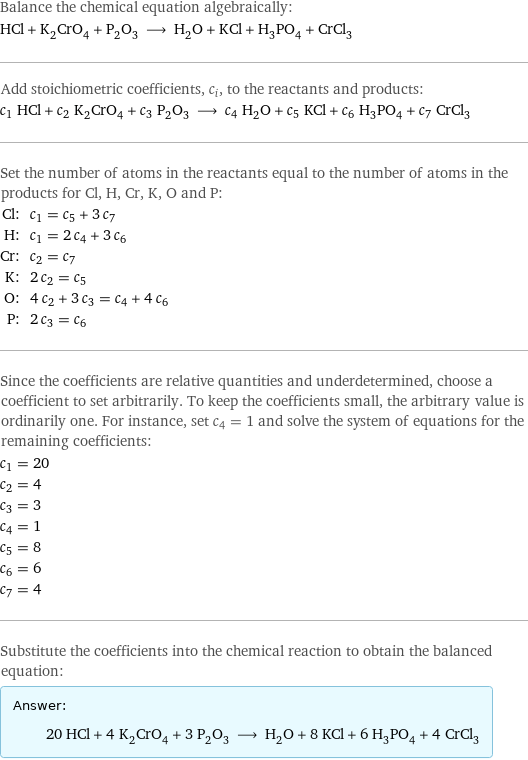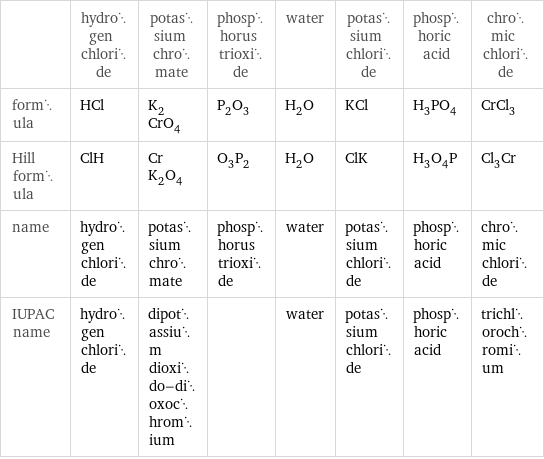Input interpretation

HCl hydrogen chloride + K_2CrO_4 potassium chromate + P_2O_3 phosphorus trioxide ⟶ H_2O water + KCl potassium chloride + H_3PO_4 phosphoric acid + CrCl_3 chromic chloride
Balanced equation

Balance the chemical equation algebraically: HCl + K_2CrO_4 + P_2O_3 ⟶ H_2O + KCl + H_3PO_4 + CrCl_3 Add stoichiometric coefficients, c_i, to the reactants and products: c_1 HCl + c_2 K_2CrO_4 + c_3 P_2O_3 ⟶ c_4 H_2O + c_5 KCl + c_6 H_3PO_4 + c_7 CrCl_3 Set the number of atoms in the reactants equal to the number of atoms in the products for Cl, H, Cr, K, O and P: Cl: | c_1 = c_5 + 3 c_7 H: | c_1 = 2 c_4 + 3 c_6 Cr: | c_2 = c_7 K: | 2 c_2 = c_5 O: | 4 c_2 + 3 c_3 = c_4 + 4 c_6 P: | 2 c_3 = c_6 Since the coefficients are relative quantities and underdetermined, choose a coefficient to set arbitrarily. To keep the coefficients small, the arbitrary value is ordinarily one. For instance, set c_4 = 1 and solve the system of equations for the remaining coefficients: c_1 = 20 c_2 = 4 c_3 = 3 c_4 = 1 c_5 = 8 c_6 = 6 c_7 = 4 Substitute the coefficients into the chemical reaction to obtain the balanced equation: Answer: | | 20 HCl + 4 K_2CrO_4 + 3 P_2O_3 ⟶ H_2O + 8 KCl + 6 H_3PO_4 + 4 CrCl_3
Structures

+ + ⟶ + + +
Names

hydrogen chloride + potassium chromate + phosphorus trioxide ⟶ water + potassium chloride + phosphoric acid + chromic chloride
Equilibrium constant
![Construct the equilibrium constant, K, expression for: HCl + K_2CrO_4 + P_2O_3 ⟶ H_2O + KCl + H_3PO_4 + CrCl_3 Plan: • Balance the chemical equation. • Determine the stoichiometric numbers. • Assemble the activity expression for each chemical species. • Use the activity expressions to build the equilibrium constant expression. Write the balanced chemical equation: 20 HCl + 4 K_2CrO_4 + 3 P_2O_3 ⟶ H_2O + 8 KCl + 6 H_3PO_4 + 4 CrCl_3 Assign stoichiometric numbers, ν_i, using the stoichiometric coefficients, c_i, from the balanced chemical equation in the following manner: ν_i = -c_i for reactants and ν_i = c_i for products: chemical species | c_i | ν_i HCl | 20 | -20 K_2CrO_4 | 4 | -4 P_2O_3 | 3 | -3 H_2O | 1 | 1 KCl | 8 | 8 H_3PO_4 | 6 | 6 CrCl_3 | 4 | 4 Assemble the activity expressions accounting for the state of matter and ν_i: chemical species | c_i | ν_i | activity expression HCl | 20 | -20 | ([HCl])^(-20) K_2CrO_4 | 4 | -4 | ([K2CrO4])^(-4) P_2O_3 | 3 | -3 | ([P2O3])^(-3) H_2O | 1 | 1 | [H2O] KCl | 8 | 8 | ([KCl])^8 H_3PO_4 | 6 | 6 | ([H3PO4])^6 CrCl_3 | 4 | 4 | ([CrCl3])^4 The equilibrium constant symbol in the concentration basis is: K_c Mulitply the activity expressions to arrive at the K_c expression: Answer: | | K_c = ([HCl])^(-20) ([K2CrO4])^(-4) ([P2O3])^(-3) [H2O] ([KCl])^8 ([H3PO4])^6 ([CrCl3])^4 = ([H2O] ([KCl])^8 ([H3PO4])^6 ([CrCl3])^4)/(([HCl])^20 ([K2CrO4])^4 ([P2O3])^3)](../image_source/f3105dc8d76191a9c4bdecfba8ed8d3f.png)
Construct the equilibrium constant, K, expression for: HCl + K_2CrO_4 + P_2O_3 ⟶ H_2O + KCl + H_3PO_4 + CrCl_3 Plan: • Balance the chemical equation. • Determine the stoichiometric numbers. • Assemble the activity expression for each chemical species. • Use the activity expressions to build the equilibrium constant expression. Write the balanced chemical equation: 20 HCl + 4 K_2CrO_4 + 3 P_2O_3 ⟶ H_2O + 8 KCl + 6 H_3PO_4 + 4 CrCl_3 Assign stoichiometric numbers, ν_i, using the stoichiometric coefficients, c_i, from the balanced chemical equation in the following manner: ν_i = -c_i for reactants and ν_i = c_i for products: chemical species | c_i | ν_i HCl | 20 | -20 K_2CrO_4 | 4 | -4 P_2O_3 | 3 | -3 H_2O | 1 | 1 KCl | 8 | 8 H_3PO_4 | 6 | 6 CrCl_3 | 4 | 4 Assemble the activity expressions accounting for the state of matter and ν_i: chemical species | c_i | ν_i | activity expression HCl | 20 | -20 | ([HCl])^(-20) K_2CrO_4 | 4 | -4 | ([K2CrO4])^(-4) P_2O_3 | 3 | -3 | ([P2O3])^(-3) H_2O | 1 | 1 | [H2O] KCl | 8 | 8 | ([KCl])^8 H_3PO_4 | 6 | 6 | ([H3PO4])^6 CrCl_3 | 4 | 4 | ([CrCl3])^4 The equilibrium constant symbol in the concentration basis is: K_c Mulitply the activity expressions to arrive at the K_c expression: Answer: | | K_c = ([HCl])^(-20) ([K2CrO4])^(-4) ([P2O3])^(-3) [H2O] ([KCl])^8 ([H3PO4])^6 ([CrCl3])^4 = ([H2O] ([KCl])^8 ([H3PO4])^6 ([CrCl3])^4)/(([HCl])^20 ([K2CrO4])^4 ([P2O3])^3)
Rate of reaction
![Construct the rate of reaction expression for: HCl + K_2CrO_4 + P_2O_3 ⟶ H_2O + KCl + H_3PO_4 + CrCl_3 Plan: • Balance the chemical equation. • Determine the stoichiometric numbers. • Assemble the rate term for each chemical species. • Write the rate of reaction expression. Write the balanced chemical equation: 20 HCl + 4 K_2CrO_4 + 3 P_2O_3 ⟶ H_2O + 8 KCl + 6 H_3PO_4 + 4 CrCl_3 Assign stoichiometric numbers, ν_i, using the stoichiometric coefficients, c_i, from the balanced chemical equation in the following manner: ν_i = -c_i for reactants and ν_i = c_i for products: chemical species | c_i | ν_i HCl | 20 | -20 K_2CrO_4 | 4 | -4 P_2O_3 | 3 | -3 H_2O | 1 | 1 KCl | 8 | 8 H_3PO_4 | 6 | 6 CrCl_3 | 4 | 4 The rate term for each chemical species, B_i, is 1/ν_i(Δ[B_i])/(Δt) where [B_i] is the amount concentration and t is time: chemical species | c_i | ν_i | rate term HCl | 20 | -20 | -1/20 (Δ[HCl])/(Δt) K_2CrO_4 | 4 | -4 | -1/4 (Δ[K2CrO4])/(Δt) P_2O_3 | 3 | -3 | -1/3 (Δ[P2O3])/(Δt) H_2O | 1 | 1 | (Δ[H2O])/(Δt) KCl | 8 | 8 | 1/8 (Δ[KCl])/(Δt) H_3PO_4 | 6 | 6 | 1/6 (Δ[H3PO4])/(Δt) CrCl_3 | 4 | 4 | 1/4 (Δ[CrCl3])/(Δt) (for infinitesimal rate of change, replace Δ with d) Set the rate terms equal to each other to arrive at the rate expression: Answer: | | rate = -1/20 (Δ[HCl])/(Δt) = -1/4 (Δ[K2CrO4])/(Δt) = -1/3 (Δ[P2O3])/(Δt) = (Δ[H2O])/(Δt) = 1/8 (Δ[KCl])/(Δt) = 1/6 (Δ[H3PO4])/(Δt) = 1/4 (Δ[CrCl3])/(Δt) (assuming constant volume and no accumulation of intermediates or side products)](../image_source/90cbf3673359c7b587ce176f2f3dd1f1.png)
Construct the rate of reaction expression for: HCl + K_2CrO_4 + P_2O_3 ⟶ H_2O + KCl + H_3PO_4 + CrCl_3 Plan: • Balance the chemical equation. • Determine the stoichiometric numbers. • Assemble the rate term for each chemical species. • Write the rate of reaction expression. Write the balanced chemical equation: 20 HCl + 4 K_2CrO_4 + 3 P_2O_3 ⟶ H_2O + 8 KCl + 6 H_3PO_4 + 4 CrCl_3 Assign stoichiometric numbers, ν_i, using the stoichiometric coefficients, c_i, from the balanced chemical equation in the following manner: ν_i = -c_i for reactants and ν_i = c_i for products: chemical species | c_i | ν_i HCl | 20 | -20 K_2CrO_4 | 4 | -4 P_2O_3 | 3 | -3 H_2O | 1 | 1 KCl | 8 | 8 H_3PO_4 | 6 | 6 CrCl_3 | 4 | 4 The rate term for each chemical species, B_i, is 1/ν_i(Δ[B_i])/(Δt) where [B_i] is the amount concentration and t is time: chemical species | c_i | ν_i | rate term HCl | 20 | -20 | -1/20 (Δ[HCl])/(Δt) K_2CrO_4 | 4 | -4 | -1/4 (Δ[K2CrO4])/(Δt) P_2O_3 | 3 | -3 | -1/3 (Δ[P2O3])/(Δt) H_2O | 1 | 1 | (Δ[H2O])/(Δt) KCl | 8 | 8 | 1/8 (Δ[KCl])/(Δt) H_3PO_4 | 6 | 6 | 1/6 (Δ[H3PO4])/(Δt) CrCl_3 | 4 | 4 | 1/4 (Δ[CrCl3])/(Δt) (for infinitesimal rate of change, replace Δ with d) Set the rate terms equal to each other to arrive at the rate expression: Answer: | | rate = -1/20 (Δ[HCl])/(Δt) = -1/4 (Δ[K2CrO4])/(Δt) = -1/3 (Δ[P2O3])/(Δt) = (Δ[H2O])/(Δt) = 1/8 (Δ[KCl])/(Δt) = 1/6 (Δ[H3PO4])/(Δt) = 1/4 (Δ[CrCl3])/(Δt) (assuming constant volume and no accumulation of intermediates or side products)
Chemical names and formulas

| hydrogen chloride | potassium chromate | phosphorus trioxide | water | potassium chloride | phosphoric acid | chromic chloride formula | HCl | K_2CrO_4 | P_2O_3 | H_2O | KCl | H_3PO_4 | CrCl_3 Hill formula | ClH | CrK_2O_4 | O_3P_2 | H_2O | ClK | H_3O_4P | Cl_3Cr name | hydrogen chloride | potassium chromate | phosphorus trioxide | water | potassium chloride | phosphoric acid | chromic chloride IUPAC name | hydrogen chloride | dipotassium dioxido-dioxochromium | | water | potassium chloride | phosphoric acid | trichlorochromium